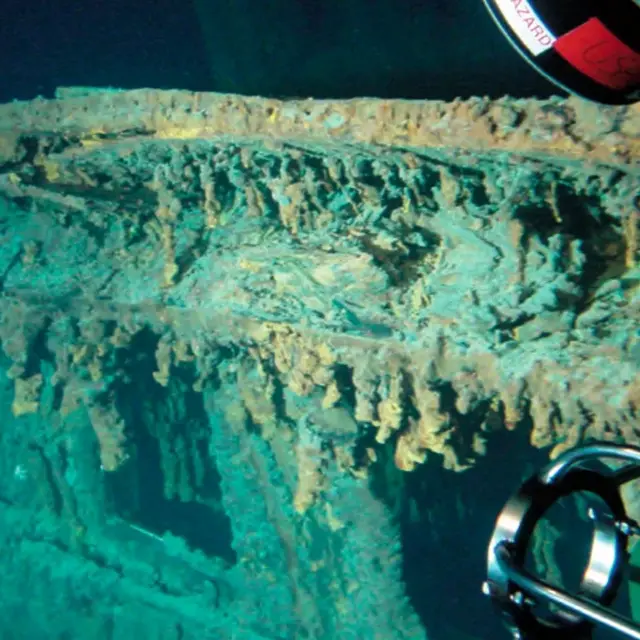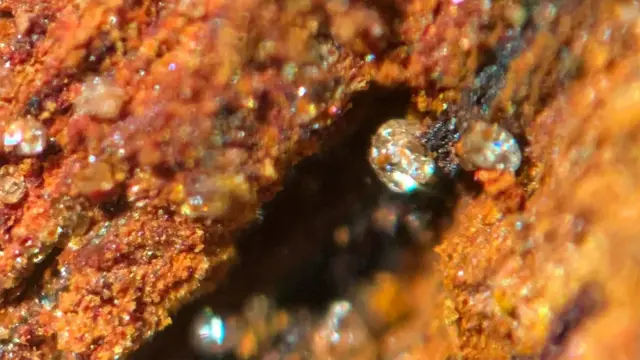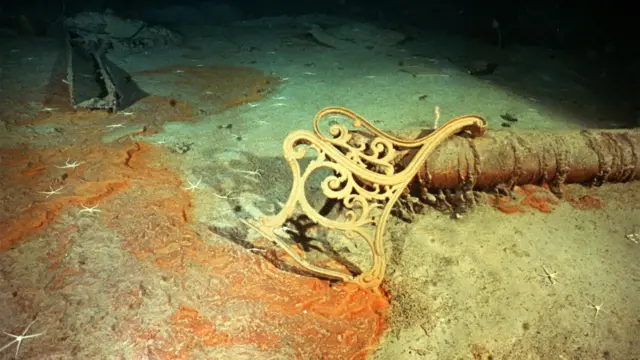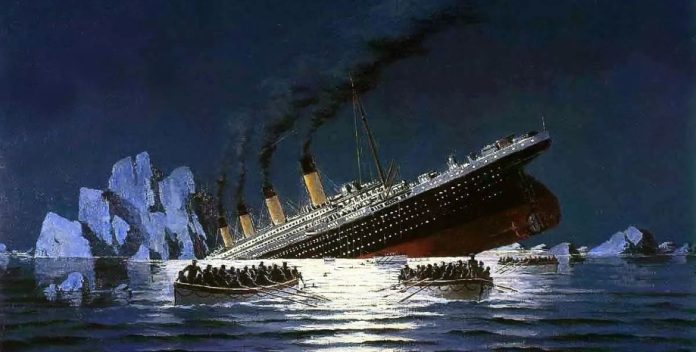Легендарний лайнер “Титанік”, який затонув більше століття тому на дні Атлантичного океану, поступово зникає. Нові дані від експедиції, що нещодавно досліджувала місце катастрофи, свідчать про те, що конструкція судна руйнується швидкими темпами, перетворюючись на підводне сміття.
Нові знімки “Титаніка” зробила цього літа американська компанія RMS Titanic Inc., що має права на роботу з уламками легендарного лайнера.
Отримані фото демонструють, як рештки лайнера змінилися за понад 100 років під водою.
“Титанік” затонув 1912 року, зіткнувшись з айсбергом, внаслідок чого загинули 1,5 тис. людей.
Автори дослідження вважають, що поручні довжиною приблизно 4,5 м обвалилися протягом останніх двох років.
“Якоїсь миті метал не витримав, і вони впали”, – каже Томасіна Рей з RMS Titanic Inc.
Це наочне свідчення того, як екстремальні умови океанських глибин руйнують рештки найвідомішого у світі судна.
Тиск океану, підводні течії на морському дні та бактерії призводять до руйнування конструкції. При цьому сам “Титанік” має дивовижний вплив на океанічне середовище.
Титанік під тиском води
Під час затоплення “Титанік” розколовся на дві частини – носову і кормову, які опинилися на морському дні на відстані майже 600 м одна від одної. Кормова частина впала на дно одразу, а носова занурювалася поступово.
Після аварії безліч предметів й уламків корпусу розкидало по морському дну. Велика частина зосереджена поблизу кормової частини “Титаніка”: від тонн вугілля до валіз, одягу, винних пляшок, умивальників, чашок, дзеркал і безлічі інших особистих речей.
Поле уламків також містить численні фрагменти самого судна, причому найбільші з них розташовані поблизу частково зруйнованої кормової частини.
На морському дні “Титанік” зазнає тиску води у приблизно 40 МПа, що в 390 разів більше, ніж на поверхні.
Зараз його руйнує власна велетенська вага. У міру того як 52 000 тонн сталі осідають на дно океану, вони тиснуть на сталевий корпус, розриваючи корабель на частини. Під час попередніх досліджень вчені помітили великі тріщини і розломи в сталевих пластинах корпусу.

Автор фото,Charles Pellegrino
“Знаковий силует затонулого лайнера поступово змінюватиметься з року в рік – і не на його користь”, – пояснює Герхард Зайфферт, керівник експедиції 2022 року, яка створила першу повноцінну цифрову модель “Титаніка”.
За словами Зайфферта, корозія поступово послаблює кістяк судна, оскільки сталеві пластини, балки та інші опорні елементи стають все тоншими.
Як Титанік іржавіє
Як і будь-яка інша сталева конструкція, “Титанік” іржавіє.
На глибині 3,8 км відбуваються інші процеси, ніж на суходолі, де іржа утворюється від взаємодії кисню, заліза й води. На “Титаніку” ж більшу частину корозії викликають бактерії.
Судно вкрите біоплівкою – живим покривалом з бактерій, морських грибків та інших мікробів, що живляться його уламками. Спочатку органічні матеріали, як-от оббивка, подушки, рушники та меблі, слугували багатим джерелом поживних речовин для мікробів, що дрейфують в океанських глибинах.
Але згодом на судні оселилися інші, більш екстремальні мікроорганізми, які, можливо, потрапили туди з морського дна чи припливли з далеких гідротермальних джерел Серединно-Атлантичного хребта.
Металеві частини “Титаніка” поступово поглинають мікроби, що призводить до появи особливих сталактитів з іржі.
“Зараз на “Титаніку” більше життя, ніж коли він плавав поверхнею океану”, – каже Лорі Джонстон, екологиня, яка досліджує мікроорганізми. Лорі вже спускалася до лайнера шість разів.
Ці “іржавостити” (від слів “іржа” й “сталактити”) – продукти життєдіяльності бактерій, що окислюють метал, який вони поїдають.
Гравітація змушує кислотну рідину стікати й утворювати цілі гілки іржі.
“Іржавостити унікальні, тому що там, на глибині, вони – домінантний вид”, – каже Джонстон.

Автор фото,Anthony El-Khouri
Одна з таких бактерій – Halomonas titanicae – раніше невідомий вид. Ця бактерія отримує енергію, споживаючи іржу, вироблену іншими мікробами або навіть хімічними реакціями у воді.
Бактерії також проникли в місця, позбавлені кисню, наприклад, у мікроскопічні щілини, що утворилися під час стискання конструкції. Вони продукують сірку, яка в морській воді перетворюється на сірчану кислоту, а потім роз’їдає судно, змушуючи його вивільняти залізо для споживання іншими мікробами.
Кормова частина судна отримала від самого початку більше ушкоджень, тому зруйнувалася на 40 років швидше, ніж носова частина, пояснює Ентоні Ель-Гурі, мікробіолог зі Східного коледжу Флориди, який працював із канадським режисером й дослідником океанських глибин Джеймсом Кемероном під час зйомок його культової стрічки “Титанік”.
Життя на уламках Титаніка
“Уламки “Титаніка” поводяться, по суті, як велика залізна оаза на морському дні вагою 46 000 тонн”, – каже Ель-Хоурі.
“Ця оаза створює живильне середовище для яскравого глибоководного рифу, населеного морськими зірками, анемонами, скляними губками, коралами і морськими огірками. І, звичайно, колоніями залізобактерій”, – каже він.
Ель-Хоурі та його колеги виявили, що ці бактерії не тільки їдять залізо на “Титаніку”, а й “здатні дихати ним” замість кисню. “Це дивовижна екосистема, що розташована далеко від Сонця, і вона може підказати, які екстремофіли (живі організми, здатні виживати та процвітати в екстремальних умовах. – Ред.) ми можемо виявити за межами Землі”, – вказує він.
“Титанік” впливає і на морське дно. Потоки іржі ширяться від затонулого судна зі швидкістю близько 10 см на рік і проникають в осадові породи на глибину до 15 см. Ці потоки особливо сконцентровані навколо кормової частини корпусу.

Автор фото,Getty Images
Загалом, за оцінками вчених, “Титанік” щодня втрачає від 0,13 до 0,2 тонни заліза зі своїх іржавих утворень.
За деякими оцінками, залізо в носовій частині корабля може повністю розчинитися через 280-420 років.
Скільки ще простоїть Титанік
Дослідження відкладень, а також рух кальмарів навколо затонулого судна дали змогу зрозуміти, як підводні течії рухають “Титанік”.
Жодну з цих течій не вважають особливо сильною, але вони можуть створити коливання, що призведуть до руйнування затонулого судна.
“Навіть течії від підводних апаратів можуть призвести до розпаду слабких конструкцій”, – пояснює Зайфферт.
Існує також імовірність того, що ці течії в решті решт поховають уламки “Титаніка” в осадових породах, перш ніж вони встигнуть повністю зруйнуватися.
Постійно лунає запитання – скільки ще простоїть “Титанік”?
“Відповіді ми не знаємо, але можемо простежити за тим, що відбувається в реальному часі”, – твердить Томасіна Рей з RMS Titanic Inc.
Автори дослідження вважають, що поручні довжиною приблизно 4,5 м обвалилися протягом останніх двох років.
Занурення, які 2019 року здійснював дослідник Віктор Весково, виявили руйнування офіцерських кают у правій частині судна, знищення салону та деяких приміщень, як-от капітанської ванної кімнати.
“За моїми оцінками, найбільш знакові ділянки, як-от фоє, радіорубка, офіцерська каюта, зникнуть приблизно у 2100 році, що зробить висадку підводників на борт “Титаніка” складнішою”, – каже Ель-Хоурі. “Тонша сталь руйнується швидше, наприклад, бильця та рубки на палубі корабля. Але навіть з такою швидкістю розпаду лайнеру знадобиться кілька століть, щоб повністю зникнути”.
За оцінками Ель-Хоурі, великі шматки сталі, поховані в осадових породах й захищені від руйнівного впливу мікробів, що роз’їдають метал, можуть проіснувати довше – можливо, кілька сотень років.
“Порцелянові предмети, приміром, яскрава плитка з обпаленого кварцу в турецьких лазнях, стоятимуть ледь не вічно”, – запевняє Ель-Хоурі.
Це буде досить скромний пам’ятник одному з найтрагічніших прикладів зарозумілості й людської слабкості. А, можливо, це буде тихий кінець судна, на яке випало стільки страждань.


